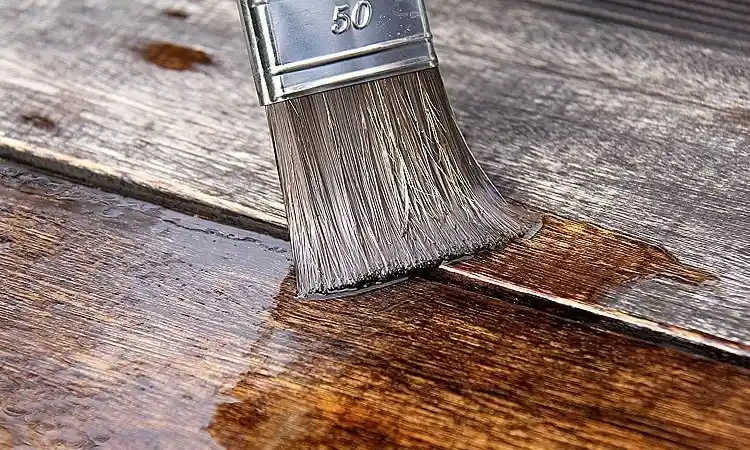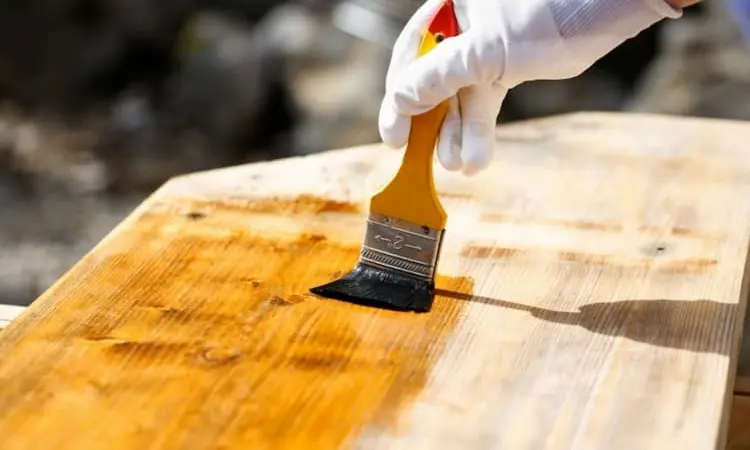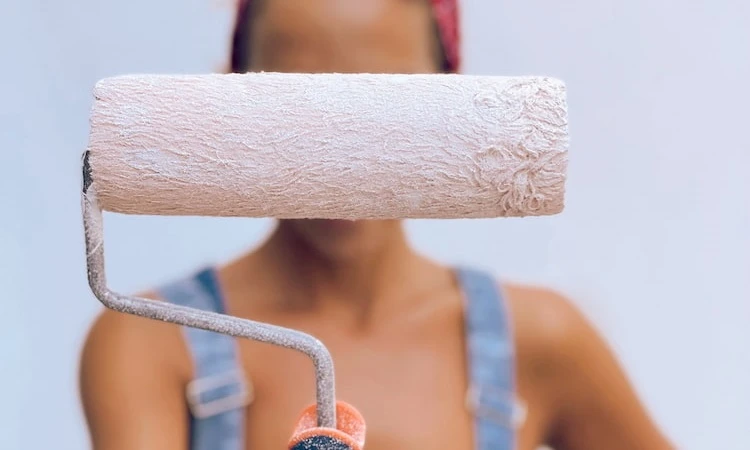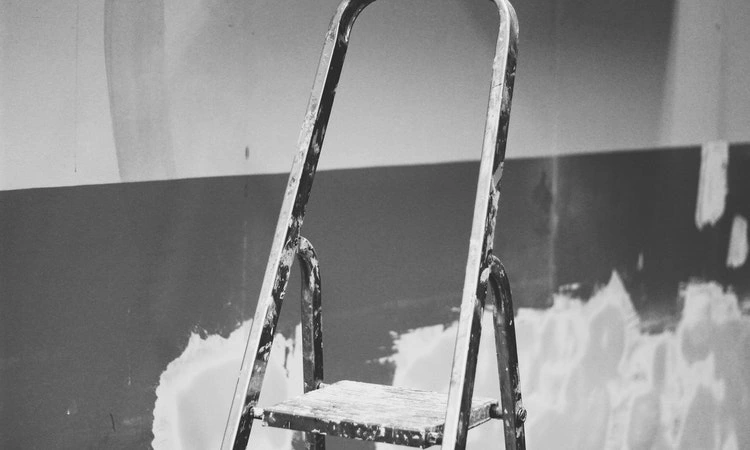Unless you’re familiar with painting and paint products, you’ll probably run across some terms you don’t know when planning projects.
For instance, the next time a DIY painting project arises, you could find yourself asking, “What in the world is polycrylic?”. Don’t feel alone, though, because I am sure you aren’t the only one.
Polycrylic is a water-based wood sealer. It is similar to polyurethane but different too.
For example, polycrylic is much less harsh smelling and toxic than polyurethane. Polyurethane also has an oil-based option, while polycrylic does not.
But a question that is usually asked more often than others is, “How long does polycrylic take to dry?”.
Numerous factors contribute to drying times varying from 2 to 3 hours or more, but one thing is for certain. Polycrylic dries more quicker than oil-based polyurethane.
Polycrylic is an excellent choice for different projects. You can apply it to wooden desks, bookshelves, end tables, dressers, etc.
However, for something like refinishing a floor, oil-based polyurethane might be a better fit.
It is considered to be more durable than polycrylic, but the latter and how long it takes to dry is the concern here.
Hence, regardless of what you’re using polycrylic for, I will see if I can make the answer to that a little clearer.

How Fast Does Polycrylic Dry?
If you ask people how fast polycrylic dries, don’t be surprised if you receive varying answers.
A quick Google search will also provide you with those same results. Some reports lean toward polycrylic drying quickly, and in as little as two hours.
Meanwhile, other accounts say the substance took forever to cure.
However, much like polyurethane and paints, it will take polycrylic around 24 hours to dry fully.
Those wanting a more accurate time frame should read the label on the particular products they purchase.
That will provide them with application/drying information and more. But don’t run off to look at it just yet. Instead, stick around and read on to see what’s in store.
How Long Does Polycrylic Take To Fully Cure?
As mentioned before, it takes 24 hours for polycrylic to cure fully. Of course, there are little things you may be able to do to speed the drying process up, but I’m not discussing them in this section.
Don’t worry; you’ll be reading it soon enough.
In as little as two hours, the coating probably won’t be sticky or tacky to the touch. So, you can apply another coat as necessary, but before allowing the wood to get subjected to anything, ensure that it sits for a full 24 hours.
Or, if you want to be safe, 48 to 72 hours might be best. This is important because if someone places a tool or object on the wood, the polycrylic might dry unevenly.
Then, you’ll have to apply another coat to create an even surface.
Or you don’t have to, I guess. That is your prerogative, but you could grow weary of looking at the blemish in a hurry.
How Long Should You Let Polycrylic Harden Between Coats?

Water-based polycrylic has a much runnier consistency than oil-based polyurethane.
Therefore, it needs to be applied thinly. Then, it is recommended that the painter allow the coat to dry for at least two hours.
After that amount of time has elapsed, he or she should apply a second coat.
Continue with this process until you get the texture and finish you desire. Just be sure to always wait two hours to let polycrylic harden before reapplication.
Reasons Why Polycrylic Can Take Too Long To Dry
There are sayings like “watching the grass grow” or “watching the paint dry” to express how utterly boring something is.
But that’s exactly what you’re doing in this case, watching the paint dry.
Don’t get in a big rush because that could lead to mistakes. Instead, take your time and get things right.
That will leave you with a job you’re proud of and one you can give yourself a pat on the back for doing.
However, it can still get annoying when something seems to take longer than it should. So, I’m going to reveal some reasons why polycrylic can take too long to dry.
If nothing else, that should give you an understanding of why the drying process could be lingering if it ever does.
And maybe, because you have this information, you won’t let the lengthy ordeal become overwhelming.
1. Heat
You might be tempted to get out a hair dryer to dry polycrylic if the drying process begins taking forever, but don’t.
Research shows that too much heat is a bad thing when it comes to drying the paint. In fact, if things are extremely hot, that will likely increase the amount of time it takes for your polycrylic coats to dry and cure.
2. Moisture
Excessive moisture can cause drying issues with polycrylic too.
Thus, if you’ll be working in or near a bathroom, make sure nobody takes a hot steamy shower for at least two hours after applying a coat to a surface.
In addition, if using a brush or roller to apply the polycrylic, ensure the tools aren’t damp. That could cause application and drying problems alike.
Not to mention, the wetness might mess with the finished product, leaving your wood with a coating that you can’t wait to redo.
3. Coat Thickness
Human error can also lead to increased polycrylic drying times. Those using the substance must put it on in thin layers.
In most cases, the polycrylic will be dry to the touch in approximately 30 minutes. Then, after that, and in about two hours, it should be cured enough for a second coat.
If additional coats are required, the polycrylic must be allowed to dry for two hours before each one is applied.
However, if you put thick layers of polycrylic on pieces of wood, there’s no telling how long the drying process will take. It will depend on the exact thickness of the coat you apply.
So, remember, thin is good when it comes to coating things with polycrylic, especially if you don’t want them to take all day and night to dry.
How To Make Polycrylic Dry Faster
Now, as promised, I’m providing you with some tips that could reduce the drying time of polycrylic.
So, if things simply aren’t going fast enough for you for some reason, keep these ideas in mind.
The one you choose should knock some precious minutes off your project time, and you can use them for whatever you like.
Blow Dryer On Cool/Medium-Heat Setting
Do you remember that blow dryer I said was a no-no because of the heat? If your device has adjustable temperature settings, it will be fine to dry polycrylic with it, providing that you make the correct adjustment.
The hair dryer must not be allowed to get over 100 to 150 degrees Fahrenheit. Typically, they reach a temp of around 300 degrees and that will make the paint dry too fast.
After getting everything set correctly, it is time to begin the deed. Turn the blow dryer on the high air speed setting.
Next, hold it approximately 5-inches away from what you’re drying and move it back and forth, letting the air circulate evenly across the piece.
Whatever you do, don’t get any closer than the 5-inches. That could fry the paint, causing it to blister and peel.
Once you’ve done this for a few minutes, you’ll need to stop. You only want to speed up the drying process, not dry the polycrylic fully. The hair dryer will do just that, speed it up, but now, wrap the cord, and put it away. The only thing left to do is wait.
Increase Air Circulation
Due to polycrylic not having a harsh smell, some people probably don’t even open windows or doors when applying it. If you land in that category, be careful.
Always try to take precautions when working with paints and chemicals. Something harmful could be in the air, even if it doesn’t smell like it.
All that aside, increasing the air circulation in the area you’re working in can speed up the polycrylic drying process.
Therefore, as long as it is safe to do so, don’t hesitate to open a door or window to let the breeze in.
That can improve the polycrylic drying time, but be sure to close and lock the opening after you’re finished.
There’s no point in giving a thief easy access. And yes, that does happen more often than most people believe.
Research shows that approximately 32 percent of burglars enter homes through unlocked entry points.
It can also help to set up a fan in the room, or if you’re in a spot with a ceiling fan, simply turn it on.
Use whatever method you feel is appropriate to improve air circulation. Then, your polycrylic will dry in less time than you had originally planned.
Set up a Dehumidifier
Don’t fret if the other two ideas do not sound very appealing. I still have something else up my sleeve.
Do you have a dehumidifier on hand, or can you rent one from a local rental company?
As discussed earlier, excessive moisture can make polycrylic seem to take forever to dry.
It could take a person days to even apply a second coat, and who has time for all that? People are busy these days, to say the very least.
Place the dehumidifier in the room near the polycrylic. The level of humidity in the room needs to be below 50 percent.
Hence, make the appropriate adjustments to the machine, keeping the dehumidifier at somewhere in the neighborhood of 30 to 50 percent. Next, turn the device on and let it run.
The number of hours to leave the dehumidifier on will vary. However, most individuals typically allow them to do what they do for at least 11 hours. That may not be enough, though, especially if it is wintertime.
When it is extremely cold outside, consider running the dehumidifier for as long as possible.
These actions should make polycrylic dry fast.
Will Polycrylic Dry in Cold Weather?
Polycrylic will dry in cold weather. It just takes the substance a long time on occasion. As long as you are not in a hurry, that may not be a big deal.
You can always return to the project a day or two later to apply another coat. That won’t work for everyone, though.
Some people are in hurries, and they need polycrylic to dry quickly. That’s fine if that is you.
Just follow the steps above to improve the drying time of polycrylic when it’s cold. Then, you’ll have the project dry and looking its best in the blink of an eye.
Is Polycrylic Toxic When Dry?
Polycrylic is not toxic when it dries. It is safe to use in kitchens, dining rooms, or anywhere because it’s non-toxic and won’t cause harm.
Additionally, polycrylic is non-flammable. Therefore, you don’t have to worry about fire risks while applying coatings.
This product can be used on baby items, and some manufacturers even go so far as to recommend polycrylic for their wooden cribs and toys.
The bottom line is that polycrylic is non-toxic. Obviously, use it at your discretion and only as directed, but it should pose no risks to you, members of the household, or your pets.
FAQs: Polycrylic Dry Time
1. Does Polycrylic Change Color as it Dries?
Polycrylic is water-based and does not dry yellow. It is a clear coating that does not change the color of wood either.
Therefore, you can use it on your projects without fear.
Of course, as with paint, you should test a small section of wood that is out of the way first.
That will allow you to see the results first-hand without messing anything up if you don’t love them.
2. Can Polycrylic Be Removed After it Dries?
If a person doesn’t like the way polycrylic looks after it dries, they can remove it easily enough. One way to accomplish this is with a water-based stripper.
Sure, there are strippers containing chemicals, but you’ve already gone this far without using them. After all, you’re using a water-based protective coating.
Wear safety gear, follow the instructions on the stripper’s label, and the polycrylic should be gone in no time flat.
3. Is Polycrylic Hard To Clean Before it Dries?
Did some droplets get somewhere they shouldn’t have? Or how about the can? Did it tump and some of the polycrylic spill?
Cleaning up polycrylic before it dries is no big deal. All you should need is a cloth to wipe, blot, and clean the spill.
However, soapy water might be necessary sometimes too.
Also, if you get polycrylic on your skin, you don’t need anything special to get it off. Instead, just wash with soap and water to get clean.
4. Can You Sand Polycrylic Once it Dries?
Sand, grit, and dust can get stuck to polycrylic while it’s being applied. That’s not a big deal if another coat will be applied because you can sand it down. Use 400 grit sandpaper to create a smooth surface.
However, the final coat cannot be sanded. Nothing abrasive should be used on it, not sandpaper, steel wool, or anything else.
So, you can remove contaminants with 400 grit sandpaper, but that should only be done before the final coat is applied.
Some Final Words
Hopefully, you now have an understanding of polycrylic and how it dries. So, what are you waiting for?
Get to it if you have wooden surfaces that need clear-coat protective finishes.
Then, you’ll soon see what the fuss is about for yourself. Who knows? You may even want to use polycrylic on every such project from here on out.



